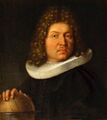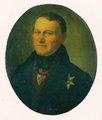Template:Selected anniversaries/January 6: Difference between revisions
No edit summary |
No edit summary |
||
| (4 intermediate revisions by the same user not shown) | |||
| Line 10: | Line 10: | ||
||1689: Seth Ward dies ... bishop, mathematician, and astronomer. No DOB. Pic. | ||1689: Seth Ward dies ... bishop, mathematician, and astronomer. No DOB. Pic. | ||
||1692: Francesco Maria Zanotti born ... philosopher and writer. His 1741 essay on the 'attractive force of ideas' defended a view of the association of ideas influenced by Newtonian physics. Pic search | ||1692: Francesco Maria Zanotti born ... philosopher and writer. His 1741 essay on the 'attractive force of ideas' defended a view of the association of ideas influenced by Newtonian physics. Pic search. | ||
||1714: Percivall Pott born ...physician and surgeon, one of the founders of orthopedics, and the first scientist to demonstrate that a cancer may be caused by an environmental carcinogen. Pic. | ||1714: Percivall Pott born ...physician and surgeon, one of the founders of orthopedics, and the first scientist to demonstrate that a cancer may be caused by an environmental carcinogen. Pic. | ||
| Line 21: | Line 21: | ||
||1795: Anselme Payen born ... chemist and academic ... known for discovering the enzyme diastase, and the carbohydrate cellulose. Pic. | ||1795: Anselme Payen born ... chemist and academic ... known for discovering the enzyme diastase, and the carbohydrate cellulose. Pic. | ||
File:Erik Laxmann.png|link=Erik Laxmann (nonfiction)|1796: Natural scientist, explorer, and clergyman [[Erik Laxmann (nonfiction)|Erik Laxmann]] dies. Laxmann contribute to the taxonomy of Siberian fauna, and attempted to establish relations between Imperial Russia and Tokugawa Japan. | |||
||1807: Joseph Petzval born ... mathematician, inventor, and physicist best known for his work in optics. Pic. | ||1807: Joseph Petzval born ... mathematician, inventor, and physicist best known for his work in optics. Pic. | ||
| Line 41: | Line 43: | ||
||1914: Kenneth Sanborn Pitzer born ... physical and theoretical chemist, educator, and university president. He was described as "one of the most influential physical chemists of his era" whose work "spanned almost all of the important fields of physical chemistry: thermodynamics, statistical mechanics, molecular structure, quantum mechanics, spectroscopy, chemical bonding, relativistic chemical effects, properties of concentrated aqueous salt solutions, kinetics, and conformational analysis." Pic. | ||1914: Kenneth Sanborn Pitzer born ... physical and theoretical chemist, educator, and university president. He was described as "one of the most influential physical chemists of his era" whose work "spanned almost all of the important fields of physical chemistry: thermodynamics, statistical mechanics, molecular structure, quantum mechanics, spectroscopy, chemical bonding, relativistic chemical effects, properties of concentrated aqueous salt solutions, kinetics, and conformational analysis." Pic. | ||
||1915: John C. Lilly born ... physician, neuroscientist, psychoanalyst, psychonaut, philosopher, writer and inventor. He was a member of a generation of counterculture scientists and thinkers that included Ram Dass, Werner Erhard and Timothy Leary, all frequent visitors to the Lilly home. He often stirred controversy, especially among mainstream scientists. Pic. | |||
File:Georg Cantor 1894.png|link=Georg Cantor (nonfiction)|1918: Mathematician and philosopher [[Georg Cantor (nonfiction)|Georg Cantor]] dies. He invented [[Set theory (nonfiction)|set theory]], a fundamental area of mathematical inquiry. | File:Georg Cantor 1894.png|link=Georg Cantor (nonfiction)|1918: Mathematician and philosopher [[Georg Cantor (nonfiction)|Georg Cantor]] dies. He invented [[Set theory (nonfiction)|set theory]], a fundamental area of mathematical inquiry. | ||
| Line 48: | Line 52: | ||
||1920: Hieronymus Georg Zeuthen dies ... mathematician. He is known for work on the enumerative geometry of conic sections, algebraic surfaces, and history of mathematics. Pic. | ||1920: Hieronymus Georg Zeuthen dies ... mathematician. He is known for work on the enumerative geometry of conic sections, algebraic surfaces, and history of mathematics. Pic. | ||
||1921: Marianne Grunberg-Manago born ... biochemist and academic. Her work helped make possible key discoveries about the nature of the genetic code. Pic search | ||1921: Marianne Grunberg-Manago born ... biochemist and academic. Her work helped make possible key discoveries about the nature of the genetic code. Pic search. | ||
||1921: Felix Villars born ... professor of physics at MIT. He is best known for the Pauli–Villars regularization, an important principle in quantum field theory Pic: http://news.mit.edu/2002/villars | ||1921: Felix Villars born ... professor of physics at MIT. He is best known for the Pauli–Villars regularization, an important principle in quantum field theory Pic: http://news.mit.edu/2002/villars | ||
| Line 70: | Line 74: | ||
||1945: Vladimir Vernadsky dies ... mineralogist and chemist. Pic. | ||1945: Vladimir Vernadsky dies ... mineralogist and chemist. Pic. | ||
||1955: Susan B. Horwitz born ... computer scientist and academic ... noted for her research on programming languages and software engineering, and in particular on program slicing and dataflow-analysis. Pic search | ||1955: Susan B. Horwitz born ... computer scientist and academic ... noted for her research on programming languages and software engineering, and in particular on program slicing and dataflow-analysis. Pic search. | ||
||1965: William Bleckwenn dies ... neurologist, psychiatrist, and military physician, who was instrumental in developing the treatment known as "narcoanalysis" or "narcosynthesis", also known by the lay term "truth serum". Pic. | ||1965: William Bleckwenn dies ... neurologist, psychiatrist, and military physician, who was instrumental in developing the treatment known as "narcoanalysis" or "narcosynthesis", also known by the lay term "truth serum". Pic. | ||
| Line 82: | Line 86: | ||
||1993: Herbert G. MacPherson dies ... nuclear engineer and deputy director of Oak Ridge National Laboratory (ORNL). He contributed to the design and development of nuclear reactors and in the opinion of Alvin Weinberg he was "the country's foremost expert on graphite". Pic: https://www.nap.edu/read/4779/chapter/30 | ||1993: Herbert G. MacPherson dies ... nuclear engineer and deputy director of Oak Ridge National Laboratory (ORNL). He contributed to the design and development of nuclear reactors and in the opinion of Alvin Weinberg he was "the country's foremost expert on graphite". Pic: https://www.nap.edu/read/4779/chapter/30 | ||
||1998: Otto Schmitt dies ... inventor, engineer, and biophysicist known for his scientific contributions to biophysics and for establishing the field of biomedical engineering. Schmitt also coined the term biomimetics and invented the Schmitt trigger, the cathode follower, the differential amplifier, and the chopper-stabilized amplifier. Pic search | ||1998: Otto Schmitt dies ... inventor, engineer, and biophysicist known for his scientific contributions to biophysics and for establishing the field of biomedical engineering. Schmitt also coined the term biomimetics and invented the Schmitt trigger, the cathode follower, the differential amplifier, and the chopper-stabilized amplifier. Pic search. | ||
||2000: Don Martin dies ... cartoonist. Pic. | ||2000: Don Martin dies ... cartoonist. Pic. | ||
| Line 90: | Line 94: | ||
||2012: Roger Boisjoly dies ... aerodynamicist and engineer. He is best known for having raised strenuous objections to the launch of the Space Shuttle Challenger months before the loss of the spacecraft and its crew in January 1986. Boisjoly correctly predicted, based on earlier flight data, that the O-rings on the rocket boosters would fail if the shuttle launched in cold weather. Pic. | ||2012: Roger Boisjoly dies ... aerodynamicist and engineer. He is best known for having raised strenuous objections to the launch of the Space Shuttle Challenger months before the loss of the spacecraft and its crew in January 1986. Boisjoly correctly predicted, based on earlier flight data, that the O-rings on the rocket boosters would fail if the shuttle launched in cold weather. Pic. | ||
</gallery> | </gallery> | ||
Latest revision as of 17:52, 7 February 2022
1561: Mathematician and physicist Thomas Fincke born. He will introduce the modern names of the trigonometric functions tangent and secant.
1655: Mathematician Jacob Bernoulli born. He will discover the fundamental mathematical constant e, and make important contributions to the field of probability.
1796: Natural scientist, explorer, and clergyman Erik Laxmann dies. Laxmann contribute to the taxonomy of Siberian fauna, and attempted to establish relations between Imperial Russia and Tokugawa Japan.
1918: Mathematician and philosopher Georg Cantor dies. He invented set theory, a fundamental area of mathematical inquiry.
1931: Inventor Thomas Edison signs his last patent application.
1990: Physicist and academic Pavel Cherenkov dies. Cherenkov shared the 1958 Nobel Prize in physics in 1958 with Ilya Frank and Igor Tamm for the discovery of Cherenkov radiation, made in 1934.





